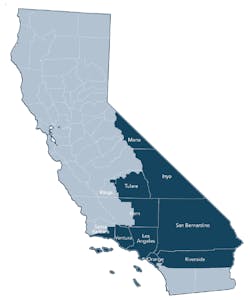The County of Los Angeles last week made an eye-opening proposal — a $41 million program that includes a regional microgrid agency to serve an area that encompasses roughly half of California’s population.
Credit: County of Los Angeles, CPUC Rulemaking 19-09-009
The county hopes to do for microgrids what a similar initiative, Southern California Regional Energy Network County (SoCalREN), did for energy efficiency. Administered by the county since 2012, SoCalREN offers energy efficiency services to a region that encompasses 700 public agencies and 20 million people. The microgrid agency would endeavour to do the same in support of microgrid development.
The microgrid proposal came in response to Governor Newsom’s July 30 emergency climate proclamation, where he warned that the state faces an electric capacity shortfall this summer and next. The California Public Utilities Commission (CPUC) asked the microgrid community for ideas on how the technology might address the governor’s concerns.
The Regional Public Agency Microgrid Program would act as a centralized resource to help local governments and public agencies implement microgrids.
In a filing seeking approval from the CPUC, the county described the microgrid agency as “urgently needed” for the state to meet its clean energy goals while providing resilient energy for electricity customers.
Tasks of the regional microgrid agency
In all, the regional agency would serve 11 counties and focus on cities, school districts, special districts, libraries, city halls, offices, police stations, public assembly facilities, parks and recreation facilities, transportation terminals and other public facilities.
Los Angeles County is asking the commission to authorize $23 million in funding over two years for the agency. The remainder of the $41 million requested would go toward building microgrids for three public facilities. The county would act as administrator of the regional microgrid agency in a contractual agreement with the local utility, which would disperse the funds.
The microgrids would provide grid services and demand flexibility — a microgrid skill set that is becoming increasingly important as strain on the US grid mounts.
The plan envisions using the microgrids’ solar, storage and building controls to reduce demand and manage consumption. The microgrids would either island or export power to the grid to meet capacity needs, or they would export power to the grid to provide ancillary services for voltage and frequency regulation. Systems would be oversized to provide the services.
Learn more about microgrids at Microgrid California, a one-day educational forum hosted by Microgrid Knowledge Oct. 5 in Foster City, California.
When there is a power outage, the microgrids would island to ensure reliable power for their hosts. They also could island during periods of peak demand to take pressure off the grid and avoid imbalances.
Credit: County of Los Angeles CPUC Rulemaking 19-09-009
Identifying microgrid opportunities
To help spur more microgrids, the county would leverage SoCalREN’s relationship with customers to identify opportunities.
“No other program in operation has the scale and deep access to customers that own and operate large portfolios of sites with substantial energy savings and dispatch potential,” said the county in the Sept. 12 filing (CPUC Rulemaking 19-09-009).
The agency would pursue contracts for the microgrids with third parties, including power purchase agreement providers, energy service companies and collaborate with demand-response and distributed energy providers to create revenue through grid services. The program includes financial incentives for distributed energy resources and resilience strategies. The regional agency also will address what it sees as delays and barriers to clean energy projects in the public sector, including lack of project management, expertise, technical assistance and understanding of financial mechanisms.
For 2022, the agency would focus on completing existing projects in the region and, in 2023, pursue 17 new microgrids. The county forecasts that the program would achieve 407 kW in demand reduction per grid event in 2022 and 9,260 kW in 2023.
Track news about Los Angeles County’s regional microgrid agency. Subscribe to the free Microgrid Knowledge Newsletter.







